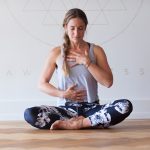
Do you know how to prepare for meditation? We’ve all been told to ground ourselves, but have you ever thought about what that actually means?
“Feel your roots grow into the ground.”
“Feel heavy in your pelvis.”
“Sink into the support beneath your body.”
All of these instructions make sense—sorta.
Grounding is a basic and common instruction when you start a meditation practice but for many people—especially scientific people–it’s meaningless.
After all, whether or not you feel “grounded,” the laws of gravity make sure you are in contact with the earth. There isn’t more or less gravity depending on how you feel that day.
So what is grounding and why is it so important?
Grounding prepares you for meditation
Grounding is a metaphoric term for calming your mind and becoming aware of the present moment. It can be divided into 2 broad categories—connecting yourself to the earth and connecting yourself with your body. In either case, using practical techniques and visualizations to make these connections helps prepare yourself for meditation.
Typically, connecting yourself to the earth means that you become aware of the force of gravity on your body—the downward pull which keeps you from flying into space. You are literally grounded.
Common instructions to connect with the earth are:
- Notice any imbalances of the weight of your body left to right, front to back and make them even. If you are tilted in one direction, if feels like you’re falling over. Balancing your body makes your base broad and even; it feels steadier.
- Release any hardness in your muscles so that the tissues of your body are soft and fold to the surface beneath them. Hard muscles prevent your body from fully contacting its support. And because they are so tense, they give little feedback about the surface below. Softening your muscles creates a fuller base and gives the sensation of being planted.
- Release your psoas to make sitting upright easy and comfortable. This instruction is common in yoga meditation sessions. In many people, the psoas is tight and can cause a “gripping” feeling, as if you need to hold yourself upright. By releasing the psoas, sitting feels easier. It gives the sensation that the earth is supporting you instead of your muscles.
- Visualize roots growing into the earth. This creates an energetic connection with the earth, especially important to people who are oriented to energetics.
The second category of grounding is to connect to your body—to become embodied.
When you live in your thoughts, you are rarely in the present moment. Thoughts take you to the past or the future. They make your airy.
Your body is very different because it lives in the present. It can only experience sensations that are happening at this moment. For example, your mind can imagine a past or future smell but your body can only smell something that exists now.
Because your body lives in the present, becoming aware of your body connects you with the present. This is very soothing to the nervous system. It calms your mind and makes meditating easier. Common instructions to connect with your body include:
- Become aware of your feet, pelvis, or back.
- Notice the sensations of your body.
- Become aware of your breath.
So by grounding yourself, you make your posture easier, calm your nervous system, and come into the present moment—3 ingredients that make your meditation much easier.
9 Ways to Ground Yourself
There are many different grounding instructions, depending on the type of meditation you are doing. If you want to experiment with grounding, these are good ways to begin. Pick an instruction from the list and follow it for 3 – 5 minutes at the start of your practice.
- Bring awareness to the lower body – the pelvis or feet
- Bring awareness to the back of the body
- Focus on your exhalation
- Notice the sensations of support beneath body–the ground, cushion, or chair
- Notice sensations in your body—what you smell, hear, feel, taste, or see
- Visualize roots growing from the base of your body into the earth
- Feel energy spirals moving down your spine into the core of the earth
- Become aware of the heaviness of the base of your body and from that, feel the lift of the spine upward
- Chant from your belly, using deep, vibrating sounds
In any meditation practice, it’s helpful to have tools that make it easier. Plopping yourself on the cushion means that you might struggle to begin meditating, or if you have already started, struggle to continue. But by taking a moment to ground yourself, to prepare yourself for your practice, your body and mind are primed. You’ll struggle less and your practice will go more smoothly.
If you enjoyed this post, you’ll love Julia’s article The Stressed Out Meditator’s Guide To Meditation



Dear Julia, Currently I try to practice meditation on a daily basis, but find it difficult to stay focus. Any tips to improve this ?
Thank You Kindly,
Esther
Hi Esther,
First of all, good on you for meditating every day! What have you noticed in your life from the practice? Have you seen any changes?
Loosing focus during meditation is perfectly normal. It happens to everyone–even the most seasoned meditators.
There are 2 things I do when I loose focus. The first thing is to use the techniques that are easiest for me.
Since you meditate every day, you have probably noticed that certain habits or techniques are easier for you than others. For example, maybe meditating in the morning is more focused than the evening. Maybe certain techniques (like focusing on the breath or sound) are easier than others. Use what works for you and when you’re distracted, move your attention to the technique that is easiest to focus on.
The second thing is to use my distraction for my meditation. When I loose focus, I think, “Huh. I just got distracted.” By bringing my awareness to the distraction, I have already re-focused.
So the next time you get distracted, just gently notice the distraction. It’s no big deal–it happens. By focusing on the distraction, you are being present.